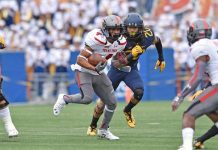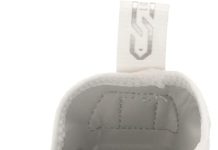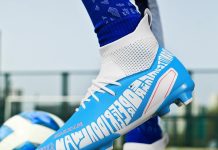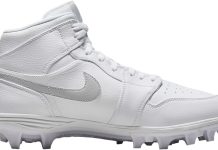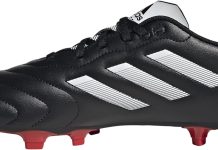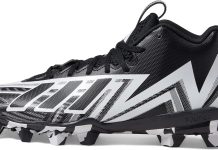In the world of professional football, the choice between cleats and turf shoes has always been a topic of curiosity. As fans, we often find ourselves wondering what footwear our favorite NFL players prefer to wear during intense games on the field. This article aims to shed some light on this perennial question and explore the reasons behind the players’ choice of footwear. So, without further ado, let’s delve into the world of NFL footwear and discover whether the pros opt for cleats or turf shoes.
Types of footwear worn by NFL players
When it comes to footwear, NFL players have two main options: cleats and turf shoes. Both types of footwear serve different purposes and are designed to optimize performance on various playing surfaces. Let’s take a closer look at each.
Review contents
Cleats
Cleats are a staple in the world of football. They are designed to provide enhanced traction on natural grass surfaces, making them the go-to choice for players who spend most of their time on traditional outdoor fields. Cleats typically feature studs or spikes on the outsole, which helps players maintain grip and stability during quick cuts, sprints, and direction changes.
Turf Shoes
Turf shoes, on the other hand, are primarily worn on artificial turf surfaces. While natural grass fields are still prevalent in the NFL, the rise of artificial turf in recent years has led to the popularity of turf shoes. These shoes feature a rubber outsole with smaller, shorter studs or knobby patterns. The design of turf shoes allows for better traction on synthetic surfaces while minimizing impact and stress on the joints.
Cleats
Definition and purpose
Cleats, as mentioned earlier, are designed to provide traction on natural grass fields. The purpose of wearing cleats is to prevent slipping and sliding, especially during high-speed movements and abrupt changes in direction. By digging into the grass, cleats help players maintain their footing and prevent unnecessary falls or accidents.
Design features
Cleats come in various designs, but they all share some common features. The upper part of the shoe is typically made of synthetic materials or leather, providing durability and flexibility. The outsole is where the studs or spikes are located, strategically placed to provide optimal traction on different areas of the foot.
Different types of cleats
There are different types of cleats designed for specific positions and playing styles. For example, linemen often opt for high-cut cleats to provide extra ankle support and stability during physical interactions with opponents. Skill-position players, on the other hand, tend to prefer low-cut or mid-cut cleats for increased agility and range of motion.
Advantages of wearing cleats
Wearing cleats offers several advantages for NFL players. First and foremost, they improve traction, allowing players to make quick cuts and accelerations without losing their footing. Cleats also provide ankle support and stability, reducing the risk of ankle sprains and other injuries. Additionally, cleats are designed to handle the demands of the sport, offering durability and protection against impact.
Disadvantages of wearing cleats
While cleats offer numerous benefits, there are also disadvantages to consider. Cleats are specifically designed for natural grass surfaces, making them less suitable for artificial turf. When worn on turf, the longer studs of cleats can get caught and increase the risk of injuries like twisted knees and ankles. Moreover, cleats can be uncomfortable when used on hard, dry field conditions, as the studs may cause pressure points and discomfort.
Turf Shoes
Definition and purpose
Turf shoes, as the name suggests, are designed for use on artificial turf surfaces. The purpose of wearing turf shoes is to improve traction and maneuverability while providing a level of cushioning to absorb the impact of running and jumping on synthetic turf.
Design features
Turf shoes have a rubber outsole with shorter, multidirectional studs or a pattern of knobby grips. This design allows for better grip and traction on the artificial turf without compromising stability. Turf shoes also tend to have a cushioned midsole, providing shock absorption and reducing the strain on the lower body.
Different types of turf shoes
Similar to cleats, turf shoes come in various styles and designs. Players can choose between low-cut, mid-cut, and high-cut options, depending on their personal preference and position requirements. Some turf shoes also feature additional ankle support and padding for players who prioritize stability and protection.
Advantages of wearing turf shoes
Turf shoes offer several advantages for NFL players, especially when playing on artificial turf. The shorter studs or knobby patterns provide excellent traction on synthetic surfaces, allowing for quick starts, stops, and changes in direction. The cushioning in turf shoes helps absorb impact and reduce stress on joints, minimizing the risk of injuries like shin splints or joint strains. The lighter weight of turf shoes also contributes to increased agility and speed.
Disadvantages of wearing turf shoes
While turf shoes excel on synthetic turf, they may not perform as well on natural grass surfaces. The shorter studs or grip patterns that give them traction on turf may not dig into the grass adequately, leading to a lack of grip and potential slipping. Additionally, the cushioning in turf shoes may not provide the same level of support and stability as cleats on very soft or muddy grass fields.
Factors influencing the choice of footwear
Several factors come into play when NFL players decide which footwear to wear for a game or practice. Understanding these factors can help players make the right choice and optimize their performance on the field.
Playing surface
The type of playing surface is one of the most critical factors in the choice of footwear. Natural grass fields call for cleats, while artificial turf surfaces require turf shoes. Players who frequently play on both types of surfaces may need to have multiple pairs of footwear on hand to adapt to different field conditions.
Weather conditions
Weather conditions also impact the choice of footwear. Cleats with longer studs are preferred on wet or muddy grass fields to provide better traction. In contrast, turf shoes are often the preferred option on dry artificial turf, regardless of weather conditions. Additionally, players may opt for specialized footwear with features like waterproofing or insulation in extreme weather conditions.
Player preferences
Each player may have their personal preferences regarding footwear. Some may feel more comfortable in cleats, while others prefer the feel and grip offered by turf shoes. Player preferences can vary based on playing style, positional requirements, or simply personal preference built over years of experience and familiarity with specific footwear.
Injury prevention
Another crucial factor in the choice of footwear is injury prevention. Different footwear options can offer varying levels of ankle support, shock absorption, and stability. Players with a history of ankle injuries may opt for cleats or turf shoes with additional ankle support to minimize the risk of re-injury. Similarly, players with previous lower body injuries may prioritize cushioning and impact absorption in their footwear choices.
Advancements in footwear technology
As with any sports equipment, footwear technology continues to evolve in the NFL. Manufacturers are constantly researching and developing new materials, designs, and technologies to enhance player performance, comfort, and safety.
Cleats
In recent years, cleats have seen advancements in material technology. Lightweight materials such as synthetic fibers and carbon fibers make modern cleats lighter, more durable, and more comfortable. Advanced traction systems and stud configurations improve grip and stability on different surfaces. Some cleats also feature enhanced ankle support systems or built-in orthotic components to provide additional protection and comfort.
Turf shoes
Similarly, turf shoes have benefitted from technological advancements. Improved rubber compounds and tread patterns enhance traction and durability on artificial turf. Innovative cushioning materials provide better shock absorption and energy return, reducing fatigue and minimizing the risk of injury. Turf shoes also incorporate breathable and moisture-wicking fabrics to keep players’ feet dry and comfortable throughout the game.
Impact on player performance
Advancements in footwear technology have a significant impact on player performance. Lighter cleats and turf shoes allow players to move faster, change direction more quickly, and exhibit greater agility on the field. Enhanced traction systems improve acceleration and deceleration, enabling players to make more precise cuts and maintain control during high-speed movements. The comfort and support provided by modern footwear also contribute to improved endurance and reduced fatigue throughout the game.
Regulation of footwear in the NFL
The NFL has specific guidelines in place regarding the types of footwear players can wear during games. These guidelines prioritize player safety and ensure fair play.
League guidelines
The NFL’s Equipment Rules specify the acceptable types of footwear for players. The rules outline the parameters for stud length, cleat designs, and the overall safety standards footwear should meet. Players must adhere to these guidelines to ensure a level playing field and minimize the risk of injuries caused by inappropriate or unsafe footwear.
Safety considerations
Player safety is a primary concern when it comes to regulating footwear in the NFL. The league aims to minimize the risk of slipping, loss of traction, and joint injuries caused by inadequate footwear choices. By implementing specific rules and guidelines, the NFL ensures that players have access to suitable footwear that aligns with the demands of the game while prioritizing their safety.
Penalty for non-compliance
If players fail to comply with the NFL’s footwear regulations, they may face penalties in the form of fines or even suspension from games. These penalties exist to deter players from wearing inappropriate or unsafe footwear and maintain fair competition among teams.
Player endorsements and sponsorships
Player endorsements and sponsorships play a significant role in the choice of footwear for NFL players. Footwear brands often seek partnerships with high-profile players, offering lucrative endorsement deals in exchange for visibility and promotion of their products.
Influence on choice of footwear
Player endorsements and sponsorships can significantly influence the choice of footwear for NFL players. Endorsement deals often come with financial incentives and access to the latest footwear models and technologies. Players may be more inclined to wear a specific brand of footwear if they have a personal endorsement deal with that brand. Furthermore, factors such as player loyalty, personal preferences, and the overall reputation of the brand can also impact their footwear choices.
Brands favored by NFL players
Several brands are favored by NFL players when it comes to footwear. Brands like Nike, Adidas, Under Armour, and Reebok have established themselves as leaders in the market, offering a wide range of cleats and turf shoes tailored to the needs of football players. These brands invest heavily in research and development, continuously innovating their footwear offerings to meet the evolving demands of the sport.
Impact on game strategy and performance
The type of footwear worn by NFL players can have a significant impact on game strategy and performance. Different aspects of the game are influenced by the characteristics of the footwear chosen.
Traction and speed
Traction is vital in football, as players often need to accelerate, change direction, and maintain stability while evading opponents. The choice of cleats or turf shoes can affect a player’s ability to gain traction on the field. Cleats, with their longer studs, provide better grip on natural grass, enabling faster acceleration and deceleration. Turf shoes, with their shorter studs or grip patterns, optimize traction on artificial turf, allowing players to maintain their speed and control.
Agility and stability
Football requires quick reactions and precise footwork, especially for skill-position players. Cleats and turf shoes offer varying degrees of agility and stability. Cleats provide a balance of support and flexibility, allowing players to make sharp cuts and changes in direction without compromising stability. Turf shoes, with their lower profile and lighter weight, enhance agility and maneuverability, enabling players to make quick, elusive movements.
Changing footwear during a game
In some cases, players may need to change their footwear during a game to adapt to changing field conditions. If the weather worsens or the playing surface becomes compromised, players may switch between cleats and turf shoes to maintain optimal traction and performance. NFL teams typically have staff members responsible for assisting players with equipment changes to ensure a seamless transition during the game.
Effect on passing and kicking
The choice of footwear can impact passing and kicking in football. Quarterbacks and kickers, in particular, rely on precise footwork and a stable planting surface for accurate throws and kicks. Cleats, with their enhanced traction and stability, assist in maintaining proper foot alignment and balance during these critical movements. Turf shoes, with their flatter outsole and cushioning, offer a level of support while enabling quick pivots and movements.
Footwear maintenance and care
Proper maintenance and care of footwear are essential for NFL players to prolong their lifespan and optimize performance. Regular cleaning, appropriate storage, and timely replacement or repair are key aspects of footwear maintenance.
Cleaning
NFL players should clean their footwear after each game or practice session. Removing dirt, mud, and debris helps maintain optimal traction and prolong the lifespan of the footwear. Cleaning methods may vary depending on the type of footwear and manufacturer recommendations. It is generally advisable to use a soft brush and mild detergent, taking care not to damage or excessively wet the shoes.
Storage
Proper storage is crucial to prevent damage to footwear. NFL players should store their cleats and turf shoes in a cool, dry place, away from direct sunlight and extreme temperatures. Shoe trees or stuffing the shoes with newspaper can help maintain their shape and prevent deformation. It is essential to ensure the shoes are fully dry before storing them to avoid mold or unpleasant odors.
Replacement and repair
Footwear undergoes wear and tear over time, and NFL players should be proactive in recognizing when their cleats or turf shoes need replacement or repair. Studs or grip patterns that have worn down significantly can compromise traction, increasing the risk of slipping or sliding. Damaged uppers, sole separation, or cushioning degradation should also be addressed promptly. In some cases, it may be more cost-effective to repair certain components of the footwear rather than replacing the entire pair.
Future trends in NFL footwear
Footwear technology in the NFL is constantly evolving, and several future trends are shaping the industry. These trends aim to enhance performance, improve player safety, and provide customization options.
Innovations in materials
The development of lightweight and durable materials is a continuous focus in footwear technology. Advancements in materials like carbon fiber, graphene, and 3D-printed components offer opportunities for improved performance and customization. These materials can provide enhanced stability, cushioning, and energy return without sacrificing durability or comfort.
Customization options
In recent years, there has been a growing trend toward customizable footwear in various sports, including football. Customization options allow players to tailor their footwear to their specific needs, providing a personalized fit and improving performance. Customizable features may include adjustable studs or soles, modular ankle support systems, or personalized color schemes and aesthetics.
Integration of technology
The integration of technology into NFL footwear is an emerging trend. Sensor technology, embedded insoles, and smart fabrics can provide valuable data on various performance metrics, such as speed, acceleration, and changes in direction. This data can help players and teams analyze performance, identify areas for improvement, and make educated decisions regarding training and game strategy.
In conclusion, the choice between cleats and turf shoes for NFL players is based on various factors such as the playing surface, weather conditions, and personal preferences. Both cleats and turf shoes offer advantages and disadvantages, depending on the specific needs of the player and the field. Advancements in footwear technology continue to drive improvements in performance, comfort, and safety for NFL players. The league also regulates footwear to ensure fair play and minimize the risk of injuries. Player endorsements and sponsorships influence footwear choices, while proper maintenance and care of footwear are essential for longevity and performance. Looking ahead, future trends in NFL footwear include innovations in materials, customization options, and the integration of technology to further enhance player performance and safety.




